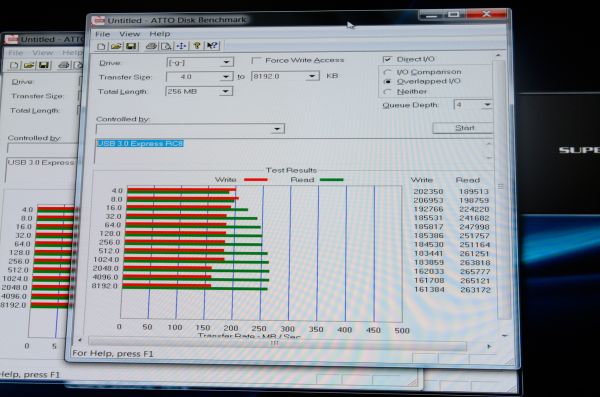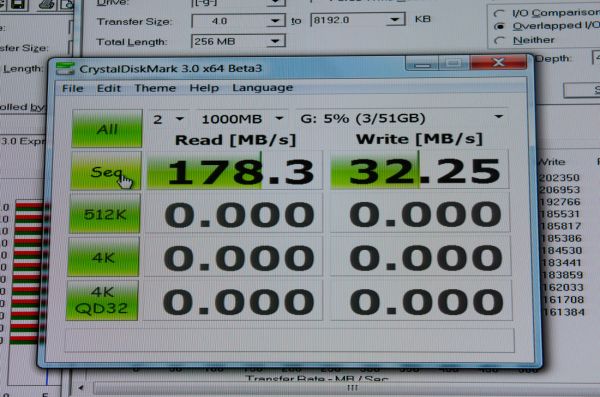Computex 2011: SuperTalent Introduces SandForce Powered USB3 Stick
by Anand Lal Shimpi on June 3, 2011 1:17 AM EST- Posted in
- Trade Shows
- SandForce
- USB 3.0
- SuperTalent
- Computex 2011
The very first enthusiast SSDs had their roots in USB drives. Memory vendors that were making USB sticks thought to put a bunch of NAND in parallel behind a rudimentary NAND to SATA controller and you had an SSD. Performance characteristics looked great on paper but of course there were teething problems.
These days the reverse has happened. High end USB sticks now look a lot like small SSDs. USB 3.0 SSDs were either too bulky to carry around or weren't that impressive from a performance standpoint, but SuperTalent just showed me one that is quite tempting.
This is the SuperTalent USB 3.0 Express RC8, it's a USB stick that has a SF-1222 controller just like the previous generation of high end SSDs:
With four NAND devices on board, the RC8 actually has 8-channels feeding two die per package. Two channels are routed to each device, hence the use of BGA NAND vs. TSOP. SuperTalent uses 25nm IMFT NAND for the drive.
Performance as a result is quite impressive. Over USB 2.0 you're looking at a maximum of around 40MB/s, but over USB 3.0 you can hit 200MB/s with highly compressible data:
Worst case performance for incompressible sequential writes over USB 3.0 is still only 32MB/s thanks to the one-die-per-channel architecture (as well as inherent SF limitations). Read speed is still excellent however at nearly 180MB/s.
The performance characteristics make this drive less ideal for copying large compressed videos to, but great for general use. In fact, running/installing applications or even running a full OS environment from the drive is likely a pretty good experience.
SuperTalent will offer the RC8 in 25GB, 50GB and 100GB capacities (with 32GB, 64GB and 128GB of NAND on board).
Expect availability starting late this month and pricing to be inline with standard SF-1222 based SSDs (~$110 for the 50GB drive).



















19 Comments
View All Comments
StevoLincolnite - Friday, June 3, 2011 - link
Can we get some Readyboost benchmarks with this thing? I'm interested to see what kind of effect it might have. :)sbrown23 - Friday, June 3, 2011 - link
I second that. How much of an effect would this have on Win7 performance used as a ReadyBoost cache?pvdw - Saturday, June 4, 2011 - link
You're much better off replacing your HDD with an SSD than using this for ReadyBoost.A drive like this would make for a great IT Tech or Forensics suite.
yyrkoon - Friday, June 3, 2011 - link
Those are pretty impressive read speeds. Too bad the writes can/could suck. The price seems fairly reasonable too, which I figured the prices would be outrageous . . . Glad to be wrong, if even in thought in this case.As for the guy above wondering about ready boost . . . spend the $100 on system memory instead . . .
GullLars - Friday, June 3, 2011 - link
Remember, that 32MB/s is for incompressible writes. I'm disappointed we didn't get to see the 512KB and 4KB random write on it. I suspect they would be 20-30MB/s.This memory stick will not have horrible performance when copying program folders and other things that have a lot of small files, like normal memory sticks usually do.
yyrkoon - Friday, June 3, 2011 - link
Well to be perfectly honest. I do not know exactly what is meant by "incompressible writes". No one can know everything, and to be perfectly honest ( again ), I am not sure I even care. e.g. If I were in the market for a USB flash device. I would already give it serious consideration based on the reads alone.Well, that, and the price for the size seem fairly reasonable. If it were much higher, I would most likely opt out for a USB2 device. Since I would use this for fixing/repairing systems a lot of the time anyways. Most of those systems will probably be USB2 only for a while.
TrackSmart - Friday, June 3, 2011 - link
I've been waiting a long time for a drive that was small enough and affordable enough to put on my keychain. If the 32GB model is under $100 and has reasonable performance, it's definitely going on my Christmas list. I prefer carrying a flash drive between home and the office, rather than lugging a laptop, but current high performance USB drives are either too bulky or too expensive to throw on my keychain. I just hope they make the final product sturdy enough to stand up to that kind of use.name99 - Friday, June 3, 2011 - link
As ALWAYS, Anand, why do you not tell us about the power draw of this thing?I've had so many problems with SSDs that claim to be bus-powered, and which work OK for a while, but then crap out on you when a large number of back-to-back writes occur.
It's downright irresponsible of you, as SSD booster, not to pressure manufacturers on this, and not to test this aggressively with every drive you review.
douglaswilliams - Friday, June 3, 2011 - link
Dude, lay off the man. He is at Computex (an electronics expo and technology show) in Taiwan! not in his office in the USA with all his typical resources at his disposal.Beyond that, it's likely that the only time he spent with the device was standing at the SuperTalent booth! He didn't get to take the device to the hotel, or to his lab, and we don't even know if he ran those benchmarks or if they are on display from the company. Since it's a picture of the benchmarks, I would guess Anand didn't run them (or else they would be screen shots). How in the world is he supposed to do a complete benchmark in that environment? Much less, take power measurements?!
And how can you call him irresponsible, as if he has a duty to you?
It's a freakin' USB drive dude. So stop dogging on Anand for not being attentive to you and your whiny amateur problems.
douglaswilliams - Friday, June 3, 2011 - link
On top of all that, this isn't labeled as a review. It's a technology preview, as with the tons of other snippets anandtech is blasting out of Computex.